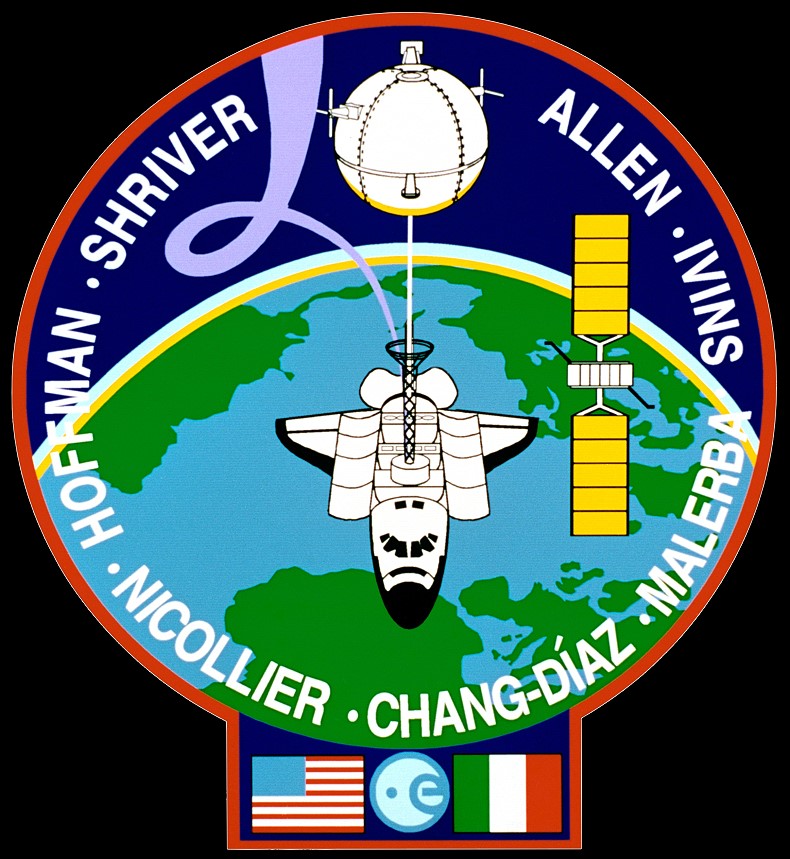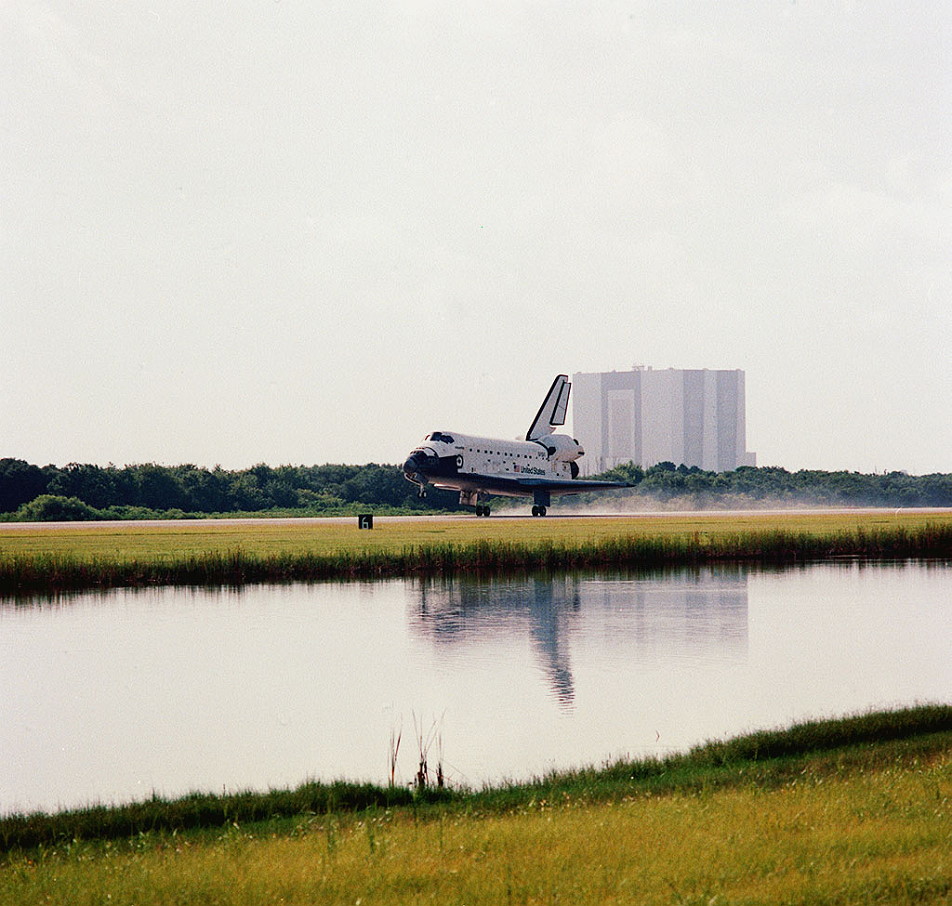
Thirty years ago today, shuttle Atlantis roared into orbit with a seven-strong crew that included the first Italian and Swiss astronauts, on a mission like no other. STS-46 would deploy the European Retrievable Carrier (EURECA), a free-flying platform packed with experiments, and Italy’s Tethered Satellite System (TSS). The latter would extend a spherical satellite into space on a 12.5-mile (20-kilometer) tether—the longest single structure ever deployed in space—to better understand the dynamics of the ionosphere.
It was hoped that this might benefit future electrical power systems and even change the velocity of future spacecraft without propellant. STS-46 Mission Specialist Marsha Ivins summed up TSS in just two words: “Weird Science”.
The crew for this ambitious mission had been in training for several years. In September 1989, NASA veterans Jeff Hoffman and Franklin Chang-Diaz were assigned to STS-46, together with Switzerland’s Claude Nicollier—the first of his countrymen to fly in space and the first European Space Agency (ESA) astronaut to serve as a mission specialist—and Commander Robert “Hoot” Gibson.
“It was something that nobody had ever done before,” Hoffman told the NASA oral historian of the marvel of TSS. “It was like learning how to go to the Moon. Nobody knew how to control a tethered satellite. In fact, the way that it had originally been designed, they had thought that this was going to be an easy thing to do. It was going to be completely automatic and all you would do is push a button. It would go up and then you’d push a button and it would come back.”

But if they needed to halt the process at mid-deployment, or if the tether went “slack” at any point, there was a heightened risk of loss of control. “The problem is when the thing really gets going, it’s coming out at several meters per second,” Hoffman continued. “That’s pretty fast. If you just slam the brakes on, it’s going to go wildly unstable. As we did more and more simulations, and we learned more and more about the system, we came up with more and more scenarios where you need these manual capabilities.”
Training had barely begun, when, in July 1990, Gibson was abruptly grounded following his participation in an air racing event in which another pilot had been killed. In December 1990, the crew complement was modified.
Veteran shuttle commander Loren Shriver would lead STS-46, joined by Jim Wetherbee in the pilot’s seat, Andy Allen as the flight engineer and Italy’s first man in space, Franco Malerba, as a payload specialist. More reshuffling of assignments came in August 1991, when Wetherbee moved to command another mission and Allen slipped into the pilot’s seat, with Marsha Ivins added as the flight engineer.
Shriver shared his crewmates’ concerns about the controllability of TSS during deployment. He knew that the issue of tether slackening was a serious worry. “The dynamics could do most anything,” said Shriver, “and it could go frontwards, and then backwards, and side to side.” The real concern was damage to the shuttle itself. Very few computer programs could model that behavior.

“Within the last couple of months of going to fly, we had some stand-alone trainers that began to show some of that in a reasonable manner,” continued Shriver, “but we never did have really good training set-ups in the shuttle mission simulator. There were some approximations, but they were never that complete or that good.”
Atlantis rose from Earth at 9:56:48 a.m. EDT on 31 July 1992. The countdown clock had been held at T-5 minutes for 48 additional seconds, to allow the Ground Launch Sequencer (GLS) to verify that the fuel isolation valve position for one of the shuttle’s Auxiliary Power Units (APUs) was closed.

Allen manually opened the valve and the countdown continued towards a perfect—though not quite on-time—launch. “We were 48 seconds late,” Allen joked at the post-flight press conference. “I was hoping that we could do it in 46 seconds, but it missed by a couple seconds.”
Allen’s first ascent to space left him in wonder at “what it took to make this happen”, in terms of the thousands of personnel who had devoted their care and excellence to getting Atlantis airborne. Shortly after achieving orbit, the STS-46 crew witnessed the first of 126 sunrises and sunsets that would glare through the windows over the next eight days.

To achieve around-the-clock TSS operations, the astronauts were divided into a pair of 12-hour “shifts”, with Allen, Nicollier and Malerba on the “blue” team and Shriver, Ivins, Hoffman and Chang-Diaz on the “red” team. Six hours after liftoff, with the blue team on duty, Nicollier grappled EURECA with the shuttle’s Remote Manipulator System (RMS) mechanical arm and positioned it over the payload bay in an “overnight park” position, ahead of deployment on 1 August.
But circumstances took an alternate turn, when a series of intermittent data problems were encountered with EURECA. Firstly, Atlantis’ payload data interleaver lost its communications link with the satellite and deployment was delayed by 24 hours to permit troubleshooting of the problem. Finally, at 3:07 a.m. EDT on 2 August, Nicollier gently released EURECA and Shriver and Allen began the procedure to move the shuttle to a station-keeping distance of about 1,000 feet (330 meters).

For a time during this period, Allen was alone on the flight deck and when Atlantis slipped into orbital darkness it was almost impossible to see the satellite. As a result, he flew off the radar, making sure that he kept an appropriate distance from EURECA.
“On a night pass, we have about ten minutes where we lose radio contact with the ground,” Allen told a Smithsonian interviewer. “We had just entered one of those periods, so there was no contact with Mission Control and no view of the satellite.”

All at once, the radar started picking up “range-rate” data, indicative of a changing position of the satellite relative to the shuttle. “At first, I thought it was a problem with the radar, but the rate kept increasing,” remembered Allen. “It finally got to the point where I figured if it was really true, it was either going to hit us in a few seconds or I had to do something about it.”
The pilot started firing off several “pretty aggressive” bursts from Atlantis’ thrusters, whose cannon-like reports soon drew a concerned Shriver up to the flight deck. Neither man could see EURECA in the gloom and, even with the benefit of flashlights aimed through the overhead windows, the view was poor.

At length, contact was re-established with Mission Control. “The control center in Germany had tried to rotate the satellite, but had sent the wrong command, which fired all the satellite’s jets,” said Allen. “Unbeknownst to Mission Control and to the crew, they fired all the jets in such a fashion as to send EURECA towards us at four to five feet per second. They couldn’t have planned it better if they wanted to hit the orbiter!”
Flight rules forbade Allen to use the thrusters within a distance of 700 feet (210 meters), lest he damage EURECA’s fragile solar arrays. He had gotten well within that range, but no damage to either the shuttle or the satellite was incurred.

The delayed deployment had already prompted the Mission Management Team (MMT) to add an extra (eighth) day onto STS-46, because TSS operations had been pushed back. The plan was to initially unreel the satellite at an angle of about 40 degrees “behind” the shuttle’s flight path, halting it at a little under a mile (1.6 kilometers) to reduce the angle to five degrees to position TSS almost directly overhead. Deployment would then resume and at a distance of 3.4 miles (5.5 kilometers) a quarter-revolution-per-minute spin would be imparted via the satellite’s cold-gas thrusters to begin a series of scientific experiments.
Next, the tether would be extended at a more rapid pace, out to a distance of nine miles (15 kilometers), before slowing again to reach the fully deployed length of 12.5 miles (20 kilometers) about 5.5 hours after the start of the deployment process. And since many features of this novel payload remained unknown, a guillotine tool could cut the tether at any stage in case of unforeseen events.

Those unforeseen events did not take long to show up. Shortly after midday EDT on 4 August, the TSS mast—not unlike a small broadcasting pylon—was unfurled without incident, allowing the first effort to deploy the tether. It moved steadily outward to 590 feet (180 meters), before stopping due to possible buried winding on the reel. It was wound back in a little, then reeled back out at a slightly higher rate to 840 feet (256 meters).
The crew’s view was spectacular. “When the Sun set,” remembered Hoffman, “and everything turned red, it was just glorious.” Next day, 5 August, the tether was retracted to 730 feet (220 meters), where it stubbornly refused to budge in either direction.

All at once, the tether appeared to contain “wiggles”, indicative of a slackness and perhaps a break or jam. “The tether hadn’t broken,” Hoffman said. “We could see that. The tether had jammed.”
Shriver knew that the current length of the tether “was right in the middle of the so-called unstable zone”. And mission rules prohibited the tether from exceeding a 45-degree “red-line” angle, beyond which it would have to be cut loose.

“Every once in a while, I listen to the audio from that,” said Hoffman. “It was certainly the wildest time that I’ve ever been in space. We were really up against the wall. We got very close to the red line, where we would’ve had to cut the tether.”
Hoffman and Chang-Diaz began preparing for a contingency Extravehicular Activity (EVA) to retrieve the tether, but fortunately this daring spacewalk—with Hoffman climbing up the TSS mast and Chang-Diaz manually reeling in the tether, hand over hand—did not prove necessary.

At length, the situation calmed. The location of the tether jam was thought to reside in the upper or lower tether control mechanism and on the afternoon of 5 August the retrieval and retraction of the satellite and mast got underway.
All told, the tether extended to a maximum distance of 840 feet (256 meters). And although the predicted 45-volt electromagnetic flux was generated, the levels of induced voltage proved insufficient to excite the physical process for many of the mission’s scientific objectives.

After eight intensive days in orbit, Atlantis landed on Runway 33 at the Kennedy Space Center (KSC) in Florida on 8 August, wrapping up the last shuttle mission to return to Earth without the benefit of a drag chute. But already there were calls for a TSS reflight.
Later in August, investigators found that the tether had gotten snagged on a bolt in the deployment mechanism. When TSS next flew in February 1996, it would be accompanied by most of the original STS-46 crew, although its outcome would be quite different.





